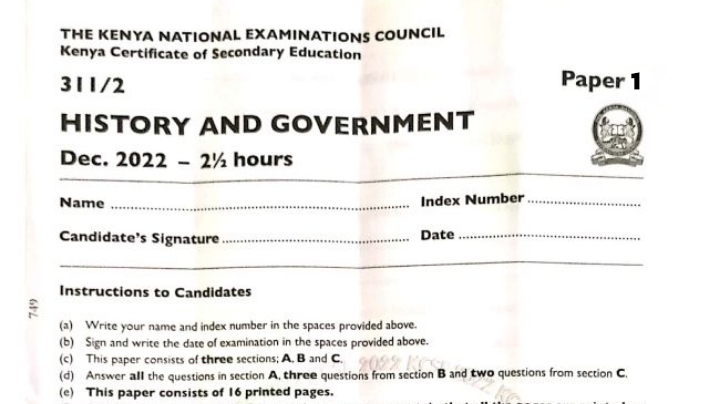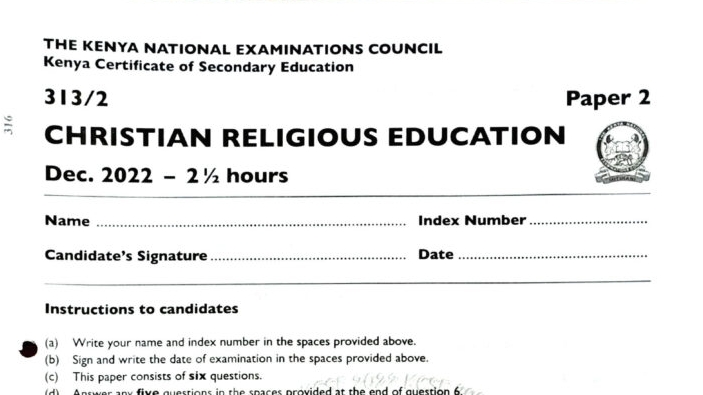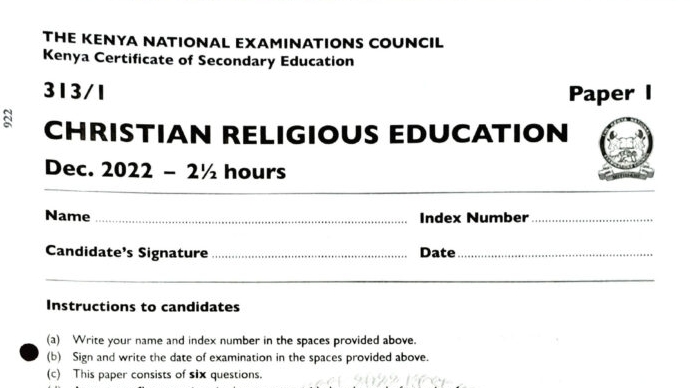KCSE 2022 History Past Paper 1 Questions And Answers
SECTION A (25 marks)
Answer all questions in this section in the spaces provided
1. Two groups of Highland Bantus in Kenya.
i. The Agikuyu
ii. The Ameru
iii. The Akamba
iv. The Aembu
v. The Mbeere/ Ambeere
2. The origin of the Southern Cushites who settled in Kenya during the pre-colonial period.
i. The Ethiopian highlands
3. Functions of the Oloibon among the Maasai in the 19th Century. (2mks)
i. He was a religious leader/ offered prayers
ii. He was a political leader/ unifying factor/ administered land
iii. He blessed warriors before they went to war/ declared war
iv. He performed rituals to ward off calamities
v. He foretold the future/ prophet
vi. He settled disputes vii. Advised council of elders
4. Main purpose of the Bill of Rights in Kenya.
i. To recognize/ protect human rights and freedoms
5. Two ways in which the use of Kiswahili promotes unity in Kenya.
i. It breaks communication barrier
ii. It gives Kenyans an identity
iii. It is an official language used in public offices/ meetings
iv. It is used in disseminating information by electronic/ print media
6. The first African to be appointed a minister in Kenya during the colonial period.
i. B.A. Ohanga
7. One House of Parliament created by the Independence Constitution.
i. The Senate/ Upper House
ii. House of Representatives / Lower House
8. Two rights of a child contained in the Constitution of Kenya.
i. The right to free compulsory basic education
ii. The right to parental care
iii. The right to name/ nationality iv. The right to survive/ nutrition/ shelter/ health care
v. The right to protection from abuse/ neglect/ discrimination/ harmful cultural practices/ violence/ inhuman treatment/ exploitation/ child labour vi. The right not to be detained
9. Two methods which were used by the British to establish colonial rule in Kenya.
i. Military expeditions/ conquests/ use of force
ii. Collaboration with some African rulers
iii. Signing treaties with local leaders/ chiefs/ diplomacy
iv. Establishing bases/ company rule v. Divide and rule
vi. Offering gifts/ treachery vii. Use of the missionaries
10. Two roles played by medicine men among the Kenyan communities during the precolonial period.
i. Treating the sick/ diagnosed diseases
ii. Acted as ritual experts
iii. They were witch doctors
iv. They were rain makers
v. They were priests/ praying/ sacrificed/ officiating religious functions
11. One feature of the education provided by the missionaries in during the colonial period.
i. It was denominational/ religious
ii. It was elementary/ basic
iii. It was industrial/ technical
12. Two similar demands of the Akamba Members Association and the Taita Hills Association.
i. Reduction of taxes
ii. An end to destocking policy
iii. The return of African land
iv. Abolition of forced labour
13. One reason why African trade unions were not in existence in Kenya before 1914.
i. The frequent movement of the Africans in search of paid labour
ii. The colonial government was against the formation of African trade unions
iii. African workers did not see the need of forming trade unions/ illiteracy
14. Main contribution of Wangari Maathai to the development of Kenya. i. Environmental conservation/ tree planting
15. Identify the political party that was formed by Oginga Odinga in 1966.
i. The Kenya Peoples Union (KPU)
16. Two categories of members of the National Assembly in Kenya.
i. Elected members of National Assembly/ constituency representatives
ii. County Woman Member of the National Assembly/ Women Representative
iii. Nominated members of National Assembly
iv. The Speaker
17. Name the institution that makes laws at the county level in Kenya.
i. The County Assembly
SECTION B (45 marks)
Answer any three questions from this section in the space provided
18.
a) Identify five sub groups of the Mijikenda in Kenya.
i. Duruma
ii. Kambe
iii. Kauma
iv. Digo
v. Chonyi
vi. Jibana
vii. Ribe
viii. Rabai
ix. Giriama
b) Explain five economic activities of the Mijikenda during the 19th Century.
i. They hunted wild animals to supplement their food
ii. They cultivated crops such as sorghum/ cassava/ millet/ sweet potatoes which could do well in their region
iii. They practiced craft/ basketry/ pottery and used the items to carry/ store their produce iv. They kept animals/ cattle/ goats/ sheep which provided meat/ milk for food
v. They practiced fishing in the Indian Ocean/ rivers in order to enrich their diet
vi. They traded with their neighbours/ Arabs/ Akamba in order to obtain what they did not produce
vii. They mined salt which was used for domestic purposes
viii. They practiced iron working/ black smithing/ making weapons/ tools which they used for defense/ other purposes
ix. They gathered wild fruits/ honey to supplement their food
19.
a) Give five levels of colonial administration in Kenya.
i. Village
ii. Sub-location
iii. Division
iv. District
v. Province
vi. Colony
b) Discuss five problems faced by workers during the construction of the Uganda Railway.
i. Rugged/ expansive terrain along the highlands/ mountains made the construction take long to complete
ii. Delay in the delivery of materials/ equipment slowed down construction work
iii. Harsh/ adverse climatic conditions across the coastal plains caused many deaths to workers
iv. Scarcity of essential supplies/ food/ water/ medicine caused suffering among workers
v. Attack by tropical diseases/ small pox/ malaria/ jiggers weakened the workers
vi. Attack by wild animals of Tsavo created fear among the workers
vii. Hostilities by some African Communities who were against alienation of their land for railway construction
viii. Strained huge shortage of labourers
20.
a) Give five achievements of the early political associations in Kenya up to 1939.
i. They aired African grievances to the colonial government
ii. They created awareness/ awakened Africans on their rights
iii. They publicized the plight of Africans under British imperialism to the international community
iv. They promoted nationalism/ national unity among African communities
v. They fought for the welfare of African workers/ better wages/ working conditions
vi. They defended African cultures
b) Describe five factors responsible for the Mau Mau uprising in Kenya.
i. The role of ex-servicemen who demystified European superiority/ lack of compensation
ii. Widespread unemployment among Africans/ closure of Karatina vegetable market
iii. Failure of colonial government to institute political reforms/ constitutional reforms
iv. Africans protested massive land alienation by white settlers
v. Europeans undermined African cultural practices e.g. female genital mutilation, polygamy
vi. Racial discrimination against Africans by European in education, health and other social facilities
vii. Brutality and cruelty of colonial administration through colonial chiefs and police/ uplands Bacon factory massacre/ Olenguruone eviction
viii. Protested poor living and working conditions in the white settlers farms
ix. Economic exploitation through forced labour and forced taxation
21.
a) Outline five factors that enabled the Nandi to resist the British invasion for a long period.
i. Their mixed economy ensured regular supply of food
ii. The Orkoiyot was the symbol of unity
iii. Familiar terrain/ ground favored Nandi fighters
iv. The British were attacked by respiratory diseases
v. Their knowledge/ skills of making arms/ availability of arms
vi. The support/ reinforcement by the Kipsigis
vii. Existence of a strong army/ military experience
viii. The use of guerilla tactics of warfare
b) Explain five results of the collaboration between the British and the Wanga during the colonial period.
i. The British enlisted services of the Wanga agents to administer Western Kenya
ii. The Wanga allowed Imperial British East African Company (IBEAC) to establish a base at Mumias which served as its headquarters
iii. The Wanga lost their independence as colonial rule was established
iv. Enmity between the Wanga and other Abaluhya sub-tribes as they felt the Wanga were betraying their course
v. Mumia was declared the paramount chief of the Wanga allowing his influence to extend to Bunyala/ Gem/ Ugenya/ Alego
vi. The Wanga warriors became agents of the British colonialism used to subdue the other resisting communities / mercenaries
vii. The Wanga received material wealth for their collaboration through trade
viii. It led to the expansion of the Wanga kingdom as it acquired more territories – Samia/ Busoga/ Bunyala
ix. Acquisition of firearms/ other exotic commodities which raised the status of King Mumia
x. It led to the introduction of Western education/ religion from the British
SECTION C (30 marks)
Answer any two questions from this section in the space provided
22.
a) Five elective positions in a general election in Kenya.
i. President
ii. Constituency Representative/ Member of National Assembly
iii. Senator
iv. Governor
v. County Woman Representative
vi. Member of County Assembly
b) Limitations of parliamentary supremacy in Kenya.
i. It may be side stepped when the president declares a state of emergency
ii. Its legislative function is bound by international laws/ treaties/ conventions/ agreements/ ratification of international treaties/ laws
iii. Its legislative authority/ oversight role may be undermined by a strong Cabinet
iv. Legislation by county government may also undermine parliamentary supremacy
v. Effectiveness of passing some legislation may be undermined by social cultural practices/ beliefs of the people
vi. It cannot pass laws/ legislation which contravenes the Constitution of Kenya
23.
a) State three circumstances which may cause the office of the County Governor to become vacant in Kenya.
i. If the governor dies
ii. If the governor is impeached
iii. If the governor resigns
iv. If the governor is mentally incapacitated/ becomes insane
v. If the County Government is dissolved by the president
vi. If he/she is convicted of an offence which attracts an imprisonment of at least 12 months
vii. Due to gross violation of the constitution
viii. If he/ she ceases to be eligible to be elected a County Governor/ Bankrupt
b) Six functions of the President of the Republic of Kenya.
i. He/she presides over public/ national days/ labour day/ Madaraka Day/ Jamhuri Day: where the country’s achievements are celebrated
ii. He/she chairs cabinet meetings where government policies are formulated/ directs and coordinates he functions of ministers
iii. He/she addresses opening of each newly elected parliament where he/she outlines the government agenda
iv. He/ she participates in law making/ legislation by signing/ assenting bills into law
v. He/she is the head of state/ government hence represents the country at local/ international level
vi. He/she nominates/ appoints with approval of parliament, senior public officers who assist in governing the country such as Cabinet secretaries/ Attorney General/ ambassadors
vii. He/ she confers honors/ medals to persons who have given distinguishes service to the nation
viii. He/ she exercises the Power of Mercy through pardoning persons convicted of various minor offences
ix. He/ she defends the constitution by ensuring adherence to the rule of law
x. He/ she, once a year gives report/ address to the nation on the progress/ state of the nation on achievements in realization of national values
xi. He/she ensures fulfillment of international obligations/ treaties by relevant government departments
xii. He/she receives foreign diplomats accredited to the country
xiii. He/she can declare a state of emergency and with the approval of parliament can declare war
24.
a) Identify three funds into which the Government of Kenya deposits its revenue.
i. Consolidated fund
ii. Revenue fund
iii. Contingencies fund
iv. Equalization fund
b) Discuss six taxes levied by the National Government of Kenya.
i. Excise duty which is charged on goods that are locally produced/ sold within the country
ii. Value added tax (VAT) which is paid to specific goods such as petroleum products/ sugar/ electronic equipment
iii. Investment revenue which is generated by government bodies/ parastatals like KPLC/ Postal Corporation/ Kenya Railway
iv. Trading licenses paid by traders wishing to operate businesses/ those operating businesses
v. Land rates paid by citizens/ companies as stamp duty/ rent/ standing premium on plots/ land adjudication/ court case fees
vi. Loan interest receipts from government bodies/ agencies that pay interest on money advanced to them by the exchequer
vii. Court fines which are charged on persons found guilty by courts of law
viii. Tourism fees which are paid by local/ foreign tourists as entrance fees into game reserves/ national parks/ other tourist attraction sites
ix. Domestic borrowing where the government raises revenue through sale of treasury bills/ bonds
x. House rates/ rent paid for the use/ hire of government buildings/ facilities
xi. Customs duty which is tax levied on goods imported into the country/ export
xii. Traffic revenue tax levied on traffic related services like driving licenses/ airport tax/ road maintenance levy
 KCSE Revision Zone
KCSE Revision Zone


